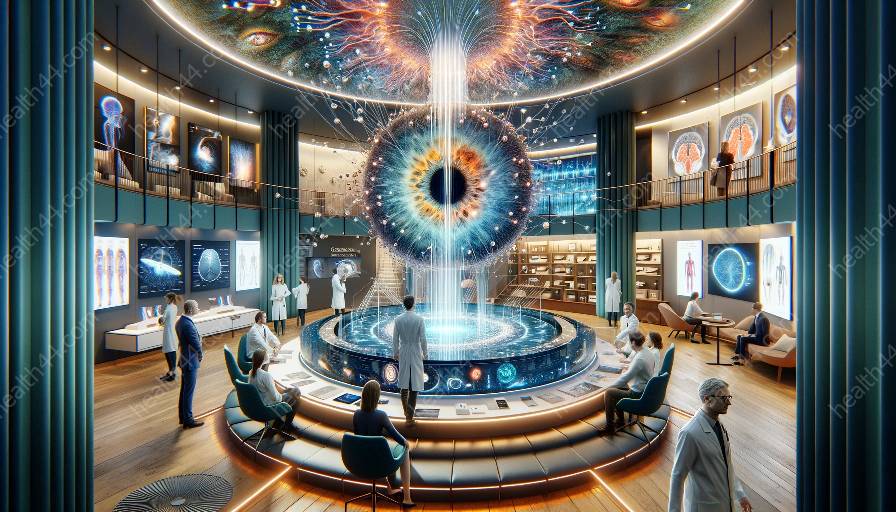Virtual reality (VR) technology has become increasingly prevalent in various fields, and its potential to revolutionize visual perception training for vision care and rehabilitation is generating significant interest and excitement. This innovative technology offers unprecedented opportunities to enhance vision care and rehabilitation efforts, providing a more immersive and effective approach to addressing visual perception issues. The future prospects for leveraging VR in visual perception training are vast and promising, with potential applications ranging from vision rehabilitation to enhancing visual acuity and depth perception.
Understanding Visual Perception and its Importance in Vision Care and Rehabilitation
Visual perception plays a crucial role in how individuals interpret and make sense of the world around them. It encompasses the processes of recognizing, organizing, and interpreting visual information, including the perception of depth, motion, form, and color. Impairments in visual perception can significantly impact an individual's quality of life, leading to difficulties in performing daily tasks, navigating their environment, and engaging in activities that require accurate visual processing.
In the context of vision care and rehabilitation, the enhancement and restoration of visual perception are fundamental goals in improving patients' visual function and overall well-being. Traditional methods of visual perception training often involve repetitive exercises and visual stimuli to stimulate and strengthen visual processing capabilities. While these approaches have been effective to some extent, the integration of virtual reality technology holds immense potential in revolutionizing visual perception training and rehabilitation.
Leveraging VR for Visual Perception Training and Rehabilitation
Virtual reality provides a simulated environment that can replicate real-world visual experiences with a high degree of fidelity. This immersive and interactive nature of VR makes it an ideal platform for visual perception training and rehabilitation, offering a dynamic and engaging approach to addressing visual impairments.
One of the significant advantages of VR in visual perception training is the ability to create customized and adaptive experiences tailored to an individual's specific visual needs and challenges. VR environments can be modified to focus on specific visual tasks, such as depth perception, visual tracking, and peripheral vision enhancement, allowing for targeted and personalized training programs.
Moreover, VR can simulate various real-world scenarios and visual challenges, providing patients with opportunities to practice and improve their visual processing abilities in a safe and controlled setting. This includes tasks such as navigating through virtual environments, identifying visual stimuli, and responding to dynamic visual cues, all of which are essential for enhancing visual perception and developing visual skills.
Potential Applications of VR in Visual Perception Training and Vision Rehabilitation
The future prospects of leveraging VR in visual perception training for vision care and rehabilitation encompass a wide range of applications, each demonstrating the transformative potential of this technology in addressing visual impairments. Some key areas where VR can significantly impact visual perception training and rehabilitation include:
- Visual Acuity Enhancement: VR-based training programs can offer targeted exercises to improve visual acuity and contrast sensitivity, addressing conditions such as low vision and visual acuity deficits.
- Depth Perception Training: VR environments can simulate depth and spatial relationships, providing immersive experiences to enhance depth perception and spatial awareness for individuals with visual impairments affecting these abilities.
- Peripheral Vision Rehabilitation: VR simulations can be designed to expand and strengthen peripheral vision, benefiting individuals with conditions such as visual field loss and peripheral vision impairments.
- Visual Attention and Tracking Exercises: VR platforms can facilitate engaging exercises to improve visual attention, tracking, and visual scanning skills, crucial for individuals with attention deficits and visual processing challenges.
- Real-World Integration and Orientation: VR experiences can aid in familiarizing individuals with real-world environments and improving their orientation and mobility skills, benefiting those with vision-related spatial navigation difficulties.
Enhanced Engagement and Motivation
VR-based visual perception training and rehabilitation offer an engaging and motivating approach that can significantly impact patients' adherence to treatment programs and overall therapy outcomes. The immersive and interactive nature of VR experiences captivates and retains patients' attention, making the training process more enjoyable and compelling. This increased engagement can lead to improved training compliance and better long-term results, as patients are more likely to participate actively and consistently in their visual perception training programs.
Integration of Advanced Technologies and Measurement Tools
Another exciting aspect of leveraging VR in visual perception training for vision care and rehabilitation lies in its compatibility with advanced measurement tools and technologies. VR environments can incorporate eye-tracking systems, visual field testing, and other diagnostic and assessment tools to monitor and evaluate patients' visual performance and progress. This integration allows for real-time feedback and data-driven adjustments to training programs, ensuring personalized and effective visual rehabilitation strategies.
Addressing Challenges and Advancing Research
The pursuit of leveraging VR for visual perception training and rehabilitation also presents opportunities to address existing challenges in traditional visual rehabilitation methods and advance the understanding of visual processing mechanisms. By integrating VR into research endeavors, professionals can explore the effectiveness of various VR-based interventions, analyze visual behavior and responses in simulated environments, and contribute to the development of evidence-based practices in visual perception training and rehabilitation.
Conclusion
The future prospects for leveraging virtual reality in visual perception training for vision care and rehabilitation are brimming with potential and promise. As this advanced technology continues to evolve and expand, it offers an exciting avenue for transforming the way visual impairments are addressed and rehabilitated. VR's ability to provide personalized, immersive, and engaging visual perception training experiences has the potential to significantly enhance the lives of individuals with visual impairments, offering hope for improved visual function, independence, and quality of life.





















